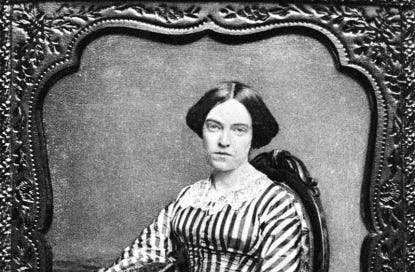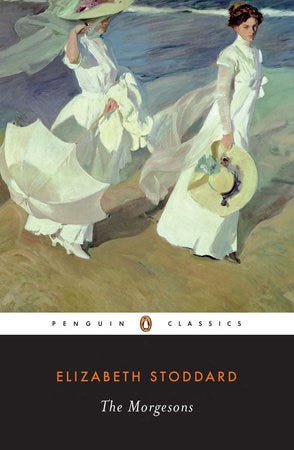Lost Voices: Elizabeth Stoddard and the Novel You Want to Read Right Now, The Morgesons
A weekly email that brings back the voices of those who have been forgotten or misremembered.
This week’s featured writer on Lost Voices is the author, Elizabeth Stoddard (1823 -1902). I came across her work thanks to the incredible Podcast Lost Ladies of Lit (More soon about Lost Ladies of Lit. I’ll be showcasing them in an interview next week!) Stoddard wrote The Morgesons (available free on Project Gutenberg or from Penguin Classics)- a brilliant feminist bildungsroman whose quirky and gender-norm-destroying protagonist puts Jane Eyre to shame. Since I discovered and read The Morgesons, I’ve taught it and can’t stop recommending it. Why? Because Stoddard’s protagonist, Cassandra (Cassy) is one of the most original characters I’ve ever met. We follow her as she grows up and gains awareness about the world around her; a world where women are expected to be demure and not want power over their lives. Cassy defies those rules.
“That child, “ said my aunt Mercy, looking at me with indigo-colored eyes, “is possessed.” —The Morgensons
You may be wondering why you’ve never heard of this book. There are two main reasons why this book has never received the reception it deserves. First, was bad timing. The book came out in 1862, nearly at the same time as the Union Army’s disastrous defeat at Bull Run. As Stoddard said in a letter to a friend, “The Morgeson’s was my Bull Run.” Second, the book was so original, that no one knew how to categorize it.
Stoddard was born and raised in the seacoast town of Mattapoisett, Massachusetts, on Buzzard’s Bay, the daughter of a wealthy shipbuilder. However, her family’s wealth was unstable. As a child, she was never accepted as a legitimate member of the local aristocracy; and as an adult, she took pleasure in satirizing the stuffiness of her native town (The Morgesons is set in a fictional version of Mattapoisett called Surrey). As a child, Stoddard read everything she could get her hands on then attended Wheaton Female Seminary where she, like Emily Dickinson, refused to accept Evangelical Protestantism. By the mid-1850s when she began publishing her writing, she had read a wide range of contemporary European and American authors such as George Sand, the Bronte sisters, Emerson, Poe, Thoreau, and Dickens.
Stoddard had a personality that by Victorian standards was considered “too much” (Don’t miss this Lost Ladies of Lit podcast about her where this idea of her and her character Cassy being too much is discussed with Victorian scholar, Rachel Vorona Cote). Meaning, she was extraverted, adventuresome, and aggressive and she considered the fact that she was outspoken a virtue. Perhaps, this is why Stoddard could write an extraordinary character like Cassy.
In 1851, at age twenty-nine, after some hesitation, she married poet Richard Stoddard, a Connecticut native who had moved to New York to become a starving artist (a la Keats). They had three children two of whom died young. Nathaniel Hawthorne helped Richard secure the appointment of inspector of customs of the Port of New York. He kept this job until 1870. Today he is largely forgotten except for the fact that he is the one who got Herman Melville a job at The Custom House. Beginning in the 1860s, their home in New York City became a literary hub where they hosted salons.
For a decade Stoddard wrote poems, stories, and sketches for periodicals. From 1854 to 1858, Stoddard contributed to a bimonthly column at the San Francisco newspaper Daily Alta California (the first daily newspaper in the West) where, in her front page column called, “From Our Lady Correspondent” she wrote humorous columns and reviewed contemporary authors such as the Brontes, George Sand, Tennyson, and Emerson. And it’s through this work that she became witness to the issues of the antebellum social scene: politics, religion, temperance, and feminism.
The Morgesons was first published in 1862. It mixes literary modes while challenging repressive gender conventions. It was never a best seller, but her book had notable admirers like Hawthorne who sent his praise for her book in a letter stating, there were few books "of which I could retain any memory so long after reading them." William D. Howells loved Stoddard’s originality, stating,"in a time when most of us had to write like Tennyson, or Longfellow, or Browning, she never would write like anyone but herself." Thomas Wentworth Higginson (Emily Dickinson’s mentor) used The Morgesons as a way to describe the Dickinson household in a letter to his wife, "if you had read Mrs. Stoddard's novels you could understand a house where each member runs his or her own selves."
Have I gotten your attention, yet? Are you ready to read this original novel? Well, here’s a chance to read it together and maybe win a free book by Charmian Kittredge London!
If you sign up for a paid membership ($5 a month/ $80 a year) I’ll send you a reading guide that will lead you through the labyrinth of this amazing novel. And the first four people who sign up will get free copies of Charmain Kittredge London’s books sent to them thanks to Sea Wolf Press.
Thanks for continuing to support Lost Voices. Don’t forget to post your comments and join the conversation! I can’t wait to hear from you.
P.S. — SANORA BABB NEWS! This week, an article I wrote about Sanora Babb and the infamous letter she received from Bennett Cerf at Random House that canceled her contract for her novel, Whose Names Are Unknown after John Steinbeck’s The Grapes of Wrath was published is up at Liber: A Feminist Review.









Stellar essay and I am hooked! I will read this book. Wishing I had the budget to subscribe; (So many books, so little time; so many substacks so little money.) Anyway, Iris's Substack high on my wish list of subscriptions.